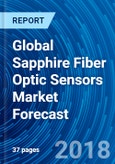This is the forecast of global market consumption value of component-level sapphire-based fiber optic sensors. Sapphire is the hardest material and has the highest melting point of any transparent material that is commonly available. The use of sapphire is desirable when fiber optic sensors are used in certain harsh environments, since sapphire is a chemical and scratch resistant material with a melting point of 2,072°C.
In addition to the properties of sapphire itself, this report addresses packaging technology, such as radiation hardening (Rad-Hard), rough handling and other concerns of the use of sensors in harsh environments.
Regions
The 2018-2024 market forecast data presented in this study report are segmented into the following geographic regions, plus a Global summary:
Sensor Types
The data in this study are presented in two independent sorts:
Applications
The market forecast of the sapphire-based fiber optic sensors systems is further segmented by application, as follows:
Fiber Optic Sensors - Market Research
Overall, fiber optic sensor technology has experienced impressive growth since the author first started providing market and technology analysis of the subject since the early 1980s. In fact analysts were tracking the various advanced photonic technologies, since 1976. In regards to fiber optic sensors, laboratory demonstrations in the 1970s of fiber-optic gyros and acoustic sensors eventually led to the introduction of the first commercial intensity and spectrally based sensors.
In addition to the properties of sapphire itself, this report addresses packaging technology, such as radiation hardening (Rad-Hard), rough handling and other concerns of the use of sensors in harsh environments.
Regions
The 2018-2024 market forecast data presented in this study report are segmented into the following geographic regions, plus a Global summary:
- America (North America, Central and South America)
- EMEA (Europe, Middle Eastern countries, plus Africa)
- APAC (Asia Pacific)
Sensor Types
The data in this study are presented in two independent sorts:
- Sapphire-based Distributed Fiber Optic Sensor - component level
- Sapphire-based Point Fiber Optic Sensors - component level
Applications
The market forecast of the sapphire-based fiber optic sensors systems is further segmented by application, as follows:
- Industrial (Manufacturing Process/Factory)
- Military/Aerospace
- Energy (Petrochemical/ Nuclear Power/Utilities/Natural Resources)
Fiber Optic Sensors - Market Research
Overall, fiber optic sensor technology has experienced impressive growth since the author first started providing market and technology analysis of the subject since the early 1980s. In fact analysts were tracking the various advanced photonic technologies, since 1976. In regards to fiber optic sensors, laboratory demonstrations in the 1970s of fiber-optic gyros and acoustic sensors eventually led to the introduction of the first commercial intensity and spectrally based sensors.
Table of Contents
1. Executive Summary1.1 Market Forecast - Overview
- Sapphire Distributed FO Sensors Forecast by Region ($Million)
- Sapphire Distributed FO Sensors Forecast by Application ($Million)
- Sapphire Point FO Sensors Forecast by Region ($Million)
- Sapphire Point FO Sensors Forecast by Application ($Million)
1.2 Technology - Overview
- Sapphire-Based Fiber Optic Point Sensor for High Temperature
- White Light Polarization Interferometry (WLPI) Technology
- Reduced Mode Sapphire Fiber and Distributed Sensing System
- Fiber Optic Sensing for Very High Temperatures
- Sapphire fiber cladding development - harsh environment sensing
- Fiber Sensors for Extreme Conditions
- Sapphire-fiber-based distributed high-temperature sensing system
- Sapphire-Based Optical Fiber Sensing
- Package Technologies
- Harsh Environment Optical Fiber
- Optical Fiber coated with carbon, metal, or silicon nitride
- Metallized Optical Fibers
- POF for humidity insensitive high temperature FBG sensors
- Laser Heated Pedestal Growth (LHPG) Sapphire Optical Fibers
- Single Crystal Sapphire Optical Fiber
- Single-Crystal Sapphire Optical Fiber Instrumentation for Coal Gasifiers
- High Temperature Sapphire Fiber Cladding
- Nanostructured Sapphire Optical Fiber (NSOF)
- High temperature sensing with FBGs in sapphire-derived all-glass fibers
- Submicron diameter single crystal sapphire optical fiber
- Modal reduction in single crystal sapphire optical fiber (SCSF)
- Sapphire photonic crystal fiber chemical sensing
- Sapphire Optical Fiber Sensor Fabrication
- Fusion Splicing of Sapphire and Silica Optical Fibers
Executive Summary
According to the Executive Summary, the combined consumption of component-level Distributed and Point (local) sapphire-based fiber optics sensors is projected to reach a global value of less than $2 million this year; however, both product categories are forecast to increase at an impressive rate of over 50% per year (2018-2024).Sapphire is the hardest material and has the highest melting point of any transparent material that is commonly available. The use of sapphire is desirable when fiber optic sensors are used in certain harsh environments, since sapphire is a chemical and scratch resistant material with a melting point of over 2,000°C.
The market forecast of the sapphire-based fiber optic sensors systems is further segmented by application, as follows: Industrial, Military/Aerospace, and Energy.
The market forecast data is presented for the America, EMEA, and APAC regions.
The data in this study are presented in two independent sorts: Sapphire-based Distributed Fiber Optic Sensor (component level) and Sapphire-based Point Fiber Optic Sensors (component level).
Overall, fiber optic sensor technology has experienced impressive growth since the author first started providing market and technology analysis of the subject in the early 1980s. In fact their analysts were tracking the various advanced photonic technologies, since 1976. In regards to fiber optic sensors, laboratory demonstrations in the 1970s of fiber-optic gyros and acoustic sensors eventually led to the introduction of the first commercial intensity and spectrally based sensors.
Companies Mentioned
- AFL
- Amphenol Fiber Optic Products
- Century Fiber Optics (Century Manufacturing Co., Inc.)
- Channell Commercial Corporation (FiberX™)
- Clearfield, Inc.
- CommScope Inc. (TE Connectivity - Raychem)
- Corning Incorporated (Corning Cable Systems)/Samsung Fiber Optics
- Cozlink (Anxun International Co., Ltd)
- Fiber Instruments Sales Inc. (FIS)
- FirstFiber.cn. Furukawa/Fitel/OFS
- ILSINTECH (America Ilsintech, LLC)
- Leviton Manufacturing Co., Incorporated
- Multilink Inc.
- Netsys Group USA
- Pacific Interconnections LLC (PI) - Pacific Interconnections Group
- PPC Worldwide (Belden)
- Preformed Line Products (PLP)
- 3M Interconnect Solutions
- Sopto Technologies Co., Ltd (Hongan Group)








